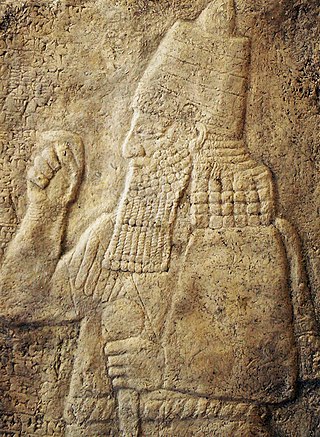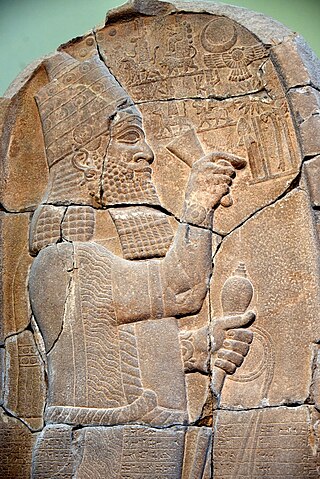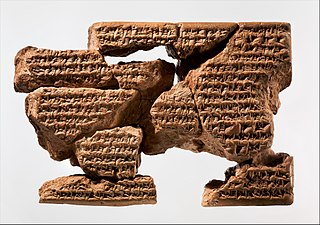
Sennacherib was the king of the Neo-Assyrian Empire from the death of his father Sargon II in 705 BC to his own death in 681 BC. The second king of the Sargonid dynasty, Sennacherib is one of the most famous Assyrian kings for the role he plays in the Hebrew Bible, which describes his campaign in the Levant. Other events of his reign include his destruction of the city of Babylon in 689 BC and his renovation and expansion of the last great Assyrian capital, Nineveh.

Shalmaneser III was king of the Neo-Assyrian Empire from the death of his father Ashurnasirpal II in 859 BC to his own death in 824 BC.
Shalmaneser IV was the king of the Neo-Assyrian Empire from 783 BC to his death in 773 BC. Shalmaneser was the son and successor of his predecessor, Adad-nirari III, and ruled during a period of Assyrian decline from which few sources survive. As such his reign, other than broad political developments, is poorly known. Shalmaneser's time was marked both by an increase in the power held by Assyrian officials relative to that of the king and Assyria's enemies growing increasingly powerful. Most of Shalmaneser's military efforts were spent warring against the Kingdom of Urartu in the north, which during this time was reaching the peak of its power.

Esarhaddon, also spelled Essarhaddon, Assarhaddon and Ashurhaddon was the king of the Neo-Assyrian Empire from the death of his father Sennacherib in 681 BC to his own death in 669. The third king of the Sargonid dynasty, Esarhaddon is most famous for his conquest of Egypt in 671 BC, which made his empire the largest the world had ever seen, and for his reconstruction of Babylon, which had been destroyed by his father.

Shalmaneser V was the king of the Neo-Assyrian Empire from the death of his father Tiglath-Pileser III in 727 BC to his deposition and death in 722 BC. Though Shalmaneser V's brief reign is poorly known from contemporary sources, he remains known for the conquest of Samaria and the fall of the Kingdom of Israel, though the conclusion of that campaign is sometimes attributed to his successor, Sargon II, instead.

Sîn-šar-iškun was the penultimate king of Assyria, reigning from the death of his brother and predecessor Aššur-etil-ilāni in 627 BC to his own death at the Fall of Nineveh in 612 BC.

Tiglath-Pileser I was a king of Assyria during the Middle Assyrian period. According to Georges Roux, Tiglath-Pileser was "one of the two or three great Assyrian monarchs since the days of Shamshi-Adad I". He was known for his "wide-ranging military campaigns, his enthusiasm for building projects, and his interest in cuneiform tablet collections". Under him, Assyria became the leading power of the Ancient Near East, a position the kingdom largely maintained for the next five hundred years. He expanded Assyrian control into Anatolia and Syria, and to the shores of the Mediterranean Sea. From his surviving inscriptions, he seems to have carefully cultivated a fear of himself in his subjects and in his enemies alike.

Aššur (; Sumerian: 𒀭𒊹𒆠 AN.ŠAR2KI, Assyrian cuneiform: Aš-šurKI, "City of God Aššur"; Syriac: ܐܫܘܪ Āšūr; Old Persian: 𐎠𐎰𐎢𐎼 Aθur, Persian: آشور Āšūr; Hebrew: אַשּׁוּר ʾAššūr, Arabic: اشور), also known as Ashur and Qal'at Sherqat, was the capital of the Old Assyrian city-state (2025–1364 BC), the Middle Assyrian Empire (1363–912 BC), and for a time, of the Neo-Assyrian Empire (911–609 BC). The remains of the city lie on the western bank of the Tigris River, north of the confluence with its tributary, the Little Zab, in what is now Iraq, more precisely in the al-Shirqat District of the Saladin Governorate.
Ashur-nirari V was the king of the Neo-Assyrian Empire from 755 BC to his death in 745 BC. Ashur-nirari was a son of Adad-nirari III and succeeded his brother Ashur-dan III as king. He ruled during a period of Assyrian decline from which few sources survive. As such his reign, other than broad political developments, is poorly known.
Ashur-dan III was the king of the Neo-Assyrian Empire from 773 BC to his death in 755 BC. Ashur-dan was a son of Adad-nirari III and succeeded his brother Shalmaneser IV as king. He ruled during a period of Assyrian decline from which few sources survive. As such his reign, other than broad political developments, is poorly known. At this time, the Assyrian officials were becoming increasingly powerful relative to the king and at the same time, Assyria's enemies were growing more dangerous. Ashur-dan's reign was a particularly difficult one as he was faced with two outbreaks of plague and five of his eighteen years as king were devoted to putting down revolts.
Adad-nārārī I, rendered in all but two inscriptions ideographically as mdadad-ZAB+DAḪ, meaning "Adad (is) my helper," was a king of Assyria during the Middle Assyrian Empire. He is the earliest Assyrian king whose annals survive in any detail. Adad-nārārī I achieved major military victories that further strengthened Assyria. In his inscriptions from Assur he calls himself son of Arik-den-ili, the same filiations being recorded in the Nassouhi kinglist. He is recorded as a son of Enlil-nirari in the Khorsabad kinglist and the SDAS kinglist, probably in error.
Aššūr-bēl-kala, inscribed maš-šur-EN-ka-la and meaning “Aššur is lord of all,” was the king of Assyria 1074/3–1056 BC, the 89th to appear on the Assyrian Kinglist. He was the son of Tukultī-apil-Ešarra I, succeeded his brother Ašarēd-apil-Ekur who had briefly preceded him, and he ruled for 18 years He was the last king of the Middle Assyrian Empire, and his later reign was preoccupied with a revolution against his rule led by one Tukulti-Mer, which, by the end of his reign, allowed hordes of Arameans to press in on Assyria's western borders. He is perhaps best known for his zoological collection.
Aššur-rēša-iši I, inscribed maš-šur-SAG-i-ši and meaning “Aššur has lifted my head,” ruled 1132–1115 BC, son of Mutakkil-Nusku, was a king of Assyria, the 86th to appear on the Assyrian King List and ruled for 18 years. The Synchronistic King List and its fragmentary copies give him as a contemporary of the Babylonian kings Ninurta-nādin-šumi, Nebuchadnezzar I and Enlil-nādin-apli, although the last of these is unlikely per the commonly accepted chronology.

Ashur, Ashshur, also spelled Ašur, Aššur was the national god of the Assyrians in ancient times until their gradual conversion to Christianity between the 1st and 5th centuries AD.

The Middle Assyrian Empire was the third stage of Assyrian history, covering the history of Assyria from the accession of Ashur-uballit I c. 1365 BC and the rise of Assyria as a territorial kingdom to the death of Ashur-dan II in 912 BC. The Middle Assyrian Empire was Assyria's first true period of ascendancy as an empire, although Assyrian kings had existed from perhaps as early as the 25th century BC, and from the 21st century BC Assyria had controlled trading colonies in Anatolia and had economic and military influence in Southern Mesopotamia, and from the late 19th century BC had been an integral part of the "Empire of Shamsi-Adad", sometimes called the Old Assyrian Empire. Though the empire experienced successive periods of expansion and decline, it remained the dominant power of Mesopotamia and often the entirety of West Asia throughout the period. In terms of Assyrian history, the Middle Assyrian period was marked by important social, political and religious developments, including the rising prominence of both the Assyrian king and the Assyrian national deity Ashur.
Puzur-Ashur I was an Assyrian king in the 21st and 20th centuries BC. He is generally regarded as the founder of Assyria as an independent city-state, c. 2025 BC.
Adad-apla-iddina, typically inscribed in cuneiform mdIM-DUMU.UŠ-SUM-na, mdIM-A-SUM-na or dIM-ap-lam-i-din-[nam] meaning the storm god “Adad has given me an heir”, was the 8th king of the 2nd Dynasty of Isin and the 4th Dynasty of Babylon and ruled c. 1064–1043. He was a contemporary of the Assyrian King Aššur-bêl-kala and his reign was a golden age for scholarship.
The Early Assyrian period was the earliest stage of Assyrian history, preceding the Old Assyrian period and covering the history of the city of Assur, and its people and culture, prior to the foundation of Assyria as an independent city-state under Puzur-Ashur I c. 2025 BC. Very little material and textual evidence survives from this period. The earliest archaeological evidence at Assur dates to the Early Dynastic Period, c. 2600 BC, but the city may have been founded even earlier since the area had been inhabited for thousands of years prior and other nearby cities, such as Nineveh, are significantly older.

The Rassam cylinder is a cuneiform cylinder, forming a prism with ten faces, written by Neo-Assyrian king Ashurbanipal in 643 BCE. The 7th century BCE cylinder was discovered in the North Palace of Nineveh by Hormuzd Rassam in 1854, hence its name. It is located in the British Museum.













